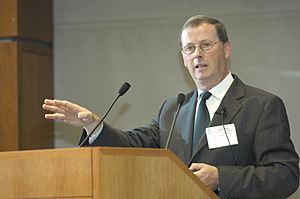Anthony Cheetham facts for kids
Quick facts for kids
Anthony Cheetham
|
|
|---|---|

|
|
| Born |
Anthony Kevin Cheetham
16 November 1946 Stockport, England
|
| Alma mater | University of Oxford |
| Scientific career | |
| Fields | Materials Chemistry |
| Institutions | |
| Thesis | Structural Studies on Defect Compounds and Solid Solutions (1971) |
| Doctoral students | |
Sir Anthony Kevin Cheetham is a famous British scientist. He was born on November 16, 1946. He is known for his work in materials chemistry, which is the study of how different materials are made and how they behave. From 2012 to 2017, he was a leader at the Royal Society, a very old and important science group in the UK.
His Education Journey
Anthony Cheetham went to Stockport Grammar School. He then studied chemistry at St Catherine's College, Oxford, starting in 1965. He finished his first degree with top honors in 1969.
He continued his studies at Wadham College, Oxford. In 1972, he earned his doctorate degree. His special research was about the structures of certain chemical compounds.
His Amazing Career
After getting his doctorate, Sir Anthony Cheetham became a research fellow at Lincoln College, Oxford. In 1974, he started teaching about how chemicals form crystals. Later, in 1990, he became a special professor in inorganic materials.
A year later, he moved to the United States. He became a professor at the University of California, Santa Barbara. There, he was the first director of their Materials Research Laboratory.
In 2007, Sir Anthony moved back to the United Kingdom. He became a professor of materials science at the University of Cambridge. He held this important job until October 2017. Today, he is still a distinguished researcher at Cambridge. He also teaches as a visiting professor at the National University of Singapore and continues his research at the University of California, Santa Barbara.
What He Studies
Sir Anthony Cheetham's research focuses on inorganic and hybrid materials. These are materials that don't come from living things, or are a mix of different types of materials. He works on creating new materials and understanding their properties. He also studies how these materials can be used in real life.
He has helped create new ways to study materials that are made of many tiny crystals. He used these methods to learn more about materials like zeolite catalysts, which help chemical reactions happen faster. He also studied molecular sieves and materials used for optics (like in lenses).
Right now, he is very interested in functional metal-organic frameworks (MOFs) and hybrid perovskites. These are exciting new materials with many possible uses, like in energy or medicine.
His Students
Many of Sir Anthony Cheetham's students have become successful scientists themselves. Some of his former doctoral students include Paul Attfield, Clare Grey, Matthew Rosseinsky, and Russell E. Morris.
Awards and Honors
Sir Anthony Cheetham has received many awards for his important work in science. Here are some of them:
- 1982: Corday-Morgan Medal and Prize from the Royal Society of Chemistry.
- 1994: He was chosen as a Fellow of the Royal Society (FRS). This is a very high honor for scientists in the UK.
- 1997: Blaise Pascal Chair in Paris, France.
- 1999: Elected a Fellow of the World Academy of Sciences (TWAS).
- 2004: Somiya Award from the International Union of Materials Research Societies.
- 2006: Received an honorary doctorate from the Université de Versailles in France.
- 2011: Platinum Medal from the Institute of Materials, Minerals and Mining.
- 2011: Became a Member of the German National Academy of Sciences.
- 2012: Nyholm Prize for Inorganic Chemistry from the Royal Society of Chemistry.
- 2014: Chemical Pioneer Award from the American Institute of Chemists.
- 2014: Elected a Member of the American Academy of Arts and Sciences.
- 2017: Basolo Medal from Northwestern University, USA.
- 2017: Became an Honorary Fellow of Trinity College, Cambridge.
- 2018: Elected an Honorary Fellow of the Singapore National Academy of Science.
- 2019: Elected a Foreign Fellow of the Indian National Science Academy.
In 2020, Sir Anthony Cheetham was made a knight by the Queen. This was to recognize his great contributions to materials chemistry, science in the UK, and his efforts to share science around the world.

